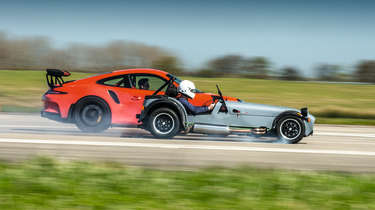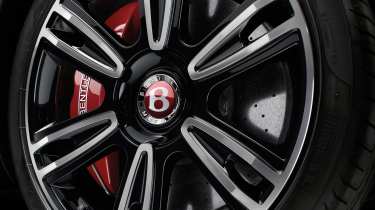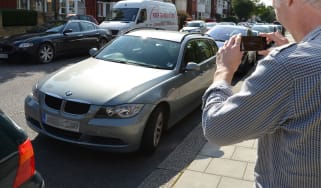Advanced braking techniques: driving masterclass
Brakes can be used for more than just slowing a car, and there’s more than one way to apply them too, as John Barker reveals

It feels great to get the power hooked up nice and early in a corner and to carry speed through the fast, difficult turns, but when it comes to shaving off the final few tenths on a circuit it’s almost always in the braking. Modern anti-lock brakes make it easier to push brake points later without too much jeopardy, and sophisticated stability control systems with mode choices such as ‘Track’ can help you safely use the rear braking to turn the car – trail-braking – without it going too far. Here we’re going to look at braking techniques that require a bit more skill, including left-foot braking, but first, let’s look at braking in cars without anti-lock.
You don’t have to go too far back to find driver’s cars without ABS. Some hot hatches from the early ’90s lacked it and, of course, back-to-basics cars such as Caterhams still go without it to this very day. The first thing to know is that, ABS or not, all cars will lock their front wheels first, but what you will find in cars without ABS is that there is more brake pedal travel to work with, more modulation built in. This means that in the event of a wheel or wheels locking, easing off the pedal pressure can get them rotating again, allowing pressure to be reapplied.
> Operating the controls: driving masterclass
‘Non-ABS cars, road or race, don’t tend to have all the response at the top of the pedal. They’re also usually pretty easy to read, with lots of feel. On the road, on road tyres, locking a wheel doesn’t happen without you thinking you’ve done something to warrant it,’ says our own Dickie Meaden, who has successfully raced many cars without anti-lock, from Cortinas to Capris to GT40s.
‘In a lightweight car like a Caterham, you can lock a wheel – it’s always the least loaded front – but you can feel it, and locking doesn’t seem to suddenly elongate your braking distance,’ he says. ‘Or you can enter the corner slightly locking a wheel and still maintain control; you can kind of work your way either side of it.’
Not all non-ABS cars are created equal, of course. ‘When I first started racing Cortinas, the team spent ages trying different types of pad material, because the brakes would just grab, just lock. The right brake pads made a massive difference. Suddenly you had much better feel, and you could drive to a point where it would just lock, or you’d hardly ever lock the brakes. There’s less feel and less margin in the wet and, of course, the bigger and heavier the car is, the harder it is to manage. And a brake servo reduces feel too.’

The beauty of ABS braking is that you can stamp on the brake pedal and continue to steer – but you have to remember to! In a non-ABS car if you do find yourself with both front wheels locked, sliding towards a hazard, always remember to steer which way you want to go and then release the brakes at the last moment; if you’ve scrubbed off enough speed, you will go that way, avoiding the hazard. Easy in theory, harder in practice, which is why skid-pan practice is valuable learning.
Left-foot braking requires some learning if you’ve not practised it from an early age, because your left leg gets used to being spare in an automatic car or stamping on the clutch in a manual. It’s also harder in modern cars with anti-lock because they tend to have instant, top-of the-pedal response. The only road cars that seem to be set up for left-foot braking are McLarens, which have a notably progressive brake pedal.
‘Once you’ve tried it,’ says Dickie, ‘and you find some finesse in your inputs, it allows you to drive a car in a slightly different way. When you learn that you can steer a car with the throttle, not just the steering, it’s a bit of a light bulb moment, and it’s the same when you realise that with the brake you can have control over more than just slowing the car, to have control over the dynamics.’
Our youngest member of staff, Yousuf Ashraf, is a left-foot braking native, having learned it in karting before he was driving on the road. ‘Left-foot braking is something I primarily use in automatic cars,’ he says. ‘The most obvious benefit for me is reducing the delay in switching from throttle to brake – and vice versa – but also the fact that before I start braking, I can rest my left foot on the pedal to make that initial application smoother and more controlled than when I quickly jump from the throttle onto the brake pedal.
‘I don’t tend to do it in manual cars unless I’m familiar with the car and road, as you obviously lose the option to go down a gear under braking if you need to – if a corner is tighter than you expected, for example. However, it can be useful for fast, well-sighted single-gear corners to smoothly blend in and out of the brakes and help the car turn in. And if you’re in a car with an oversteery balance on corner entry, it frees you up to blend-in a touch of throttle to stabilise the car while braking.
‘All of the above apply whether it’s wet or dry, but I did some ice driving recently and found it especially helpful to load up the front of the car in long or tightening corners to hold a tighter line.
‘In theory these benefits also apply on track, but in road cars with unsupportive seats, or without harness belts, your braking finesse can suffer if you use your left foot, because you’re not able to brace yourself against the footrest while braking. In these cases I tend to use my right foot instead.
‘I wouldn’t say that it’s an essential skill to learn, and you can have exceptional car control and smoothness without it, but for those final few per cent I think it’s helpful.’
This story first featured in evo issue 331.



